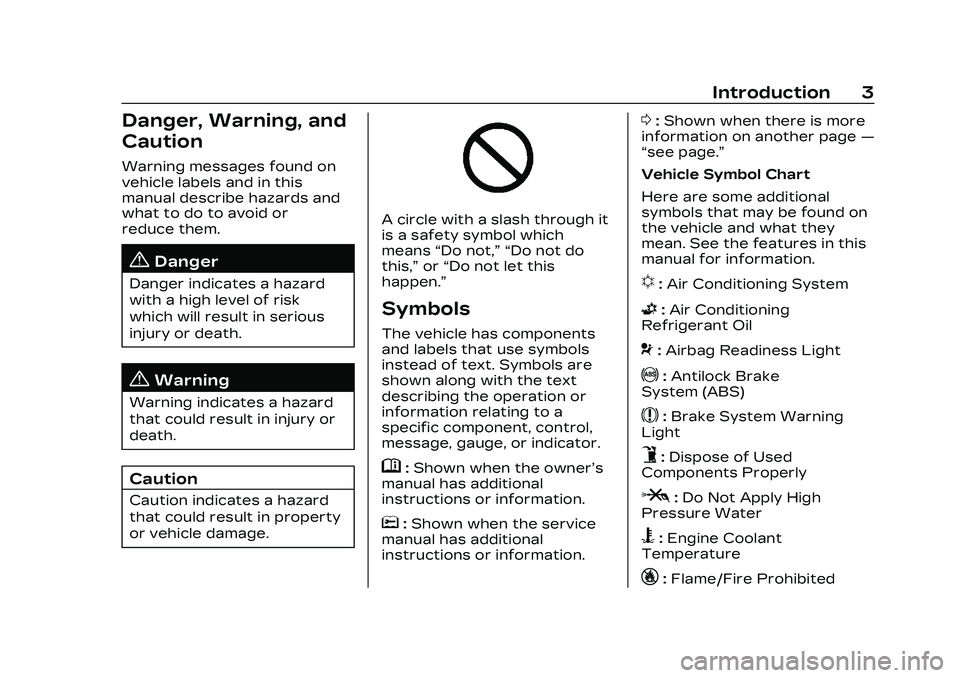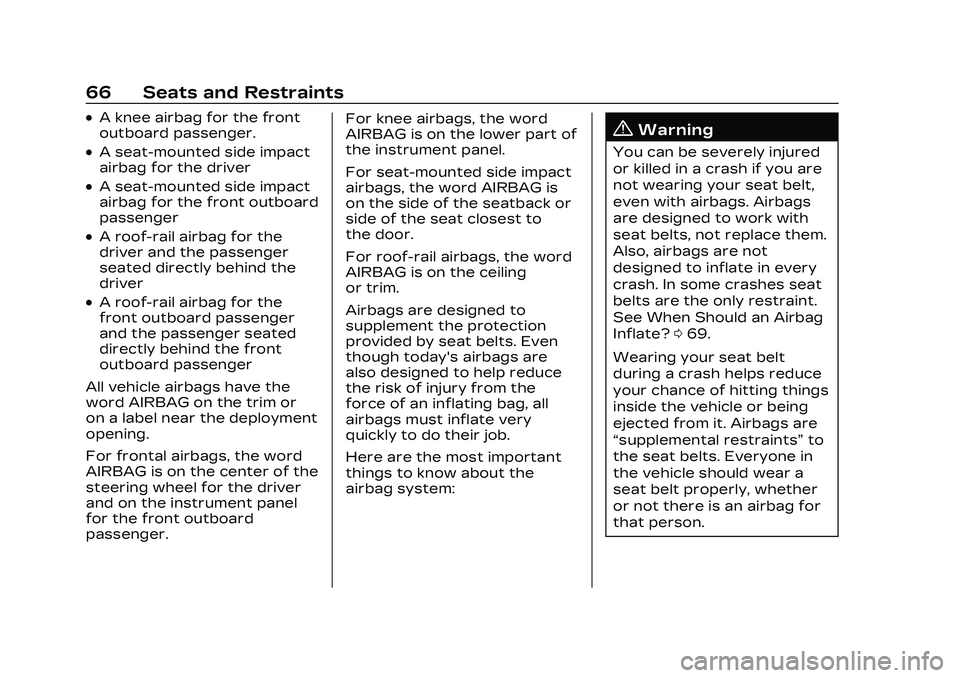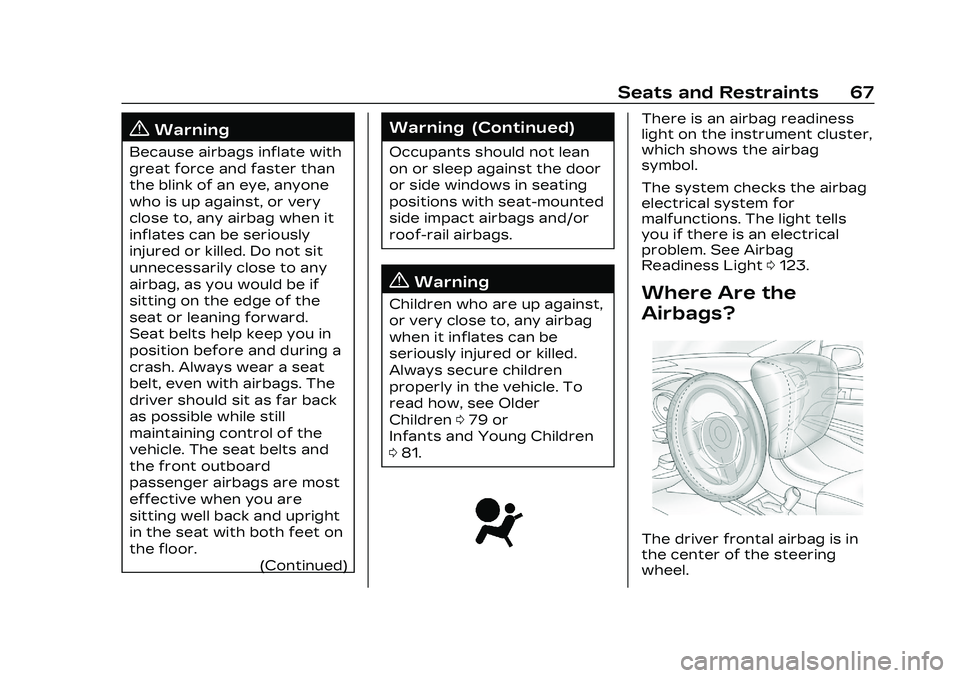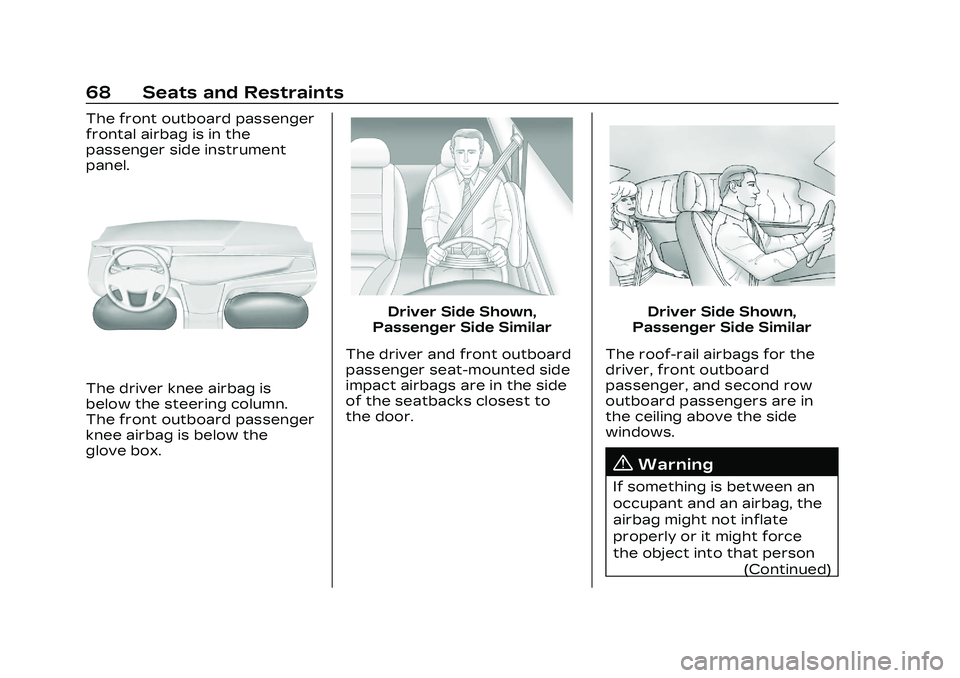airbag CADILLAC CT5 2023 Owners Manual
[x] Cancel search | Manufacturer: CADILLAC, Model Year: 2023, Model line: CT5, Model: CADILLAC CT5 2023Pages: 526, PDF Size: 6.85 MB
Page 4 of 526

Cadillac CT5 Owner Manual (GMNA-Localizing-U.S./Canada-16500419) -
2023 - CRC - 5/6/22
Introduction 3
Danger, Warning, and
Caution
Warning messages found on
vehicle labels and in this
manual describe hazards and
what to do to avoid or
reduce them.
{Danger
Danger indicates a hazard
with a high level of risk
which will result in serious
injury or death.
{Warning
Warning indicates a hazard
that could result in injury or
death.
Caution
Caution indicates a hazard
that could result in property
or vehicle damage.
A circle with a slash through it
is a safety symbol which
means“Do not,” “Do not do
this,” or“Do not let this
happen.”
Symbols
The vehicle has components
and labels that use symbols
instead of text. Symbols are
shown along with the text
describing the operation or
information relating to a
specific component, control,
message, gauge, or indicator.
M: Shown when the owner’s
manual has additional
instructions or information.
*: Shown when the service
manual has additional
instructions or information.
0: Shown when there is more
information on another page —
“see page.”
Vehicle Symbol Chart
Here are some additional
symbols that may be found on
the vehicle and what they
mean. See the features in this
manual for information.
u: Air Conditioning System
G:Air Conditioning
Refrigerant Oil
9: Airbag Readiness Light
!:Antilock Brake
System (ABS)
$: Brake System Warning
Light
9: Dispose of Used
Components Properly
P: Do Not Apply High
Pressure Water
B: Engine Coolant
Temperature
_: Flame/Fire Prohibited
Page 43 of 526

Cadillac CT5 Owner Manual (GMNA-Localizing-U.S./Canada-16500419) -
2023 - CRC - 5/6/22
42 Seats and Restraints
Seats and
Restraints
Head Restraints
Head Restraints . . . . . . . . . . . . . 43
Front Seats
Power Seat Adjustment . . . 44
Thigh SupportAdjustment . . . . . . . . . . . . . . . . . . 45
Reclining Seatbacks . . . . . . . . 45
Lumbar Adjustment . . . . . . . . 46
Massage . . . . . . . . . . . . . . . . . . . . . . . 47
Memory Seats . . . . . . . . . . . . . . . 48
Heated and Ventilated Front Seats . . . . . . . . . . . . . . . . . . 51
Rear Seats
Rear Seats . . . . . . . . . . . . . . . . . . . . 53
Seat Belts
Seat Belts . . . . . . . . . . . . . . . . . . . . . 55
Buckle To Drive . . . . . . . . . . . . . . 56
How to Wear Seat BeltsProperly . . . . . . . . . . . . . . . . . . . . . . 57
Lap-Shoulder Belt . . . . . . . . . . 60
Seat Belt Use During Pregnancy . . . . . . . . . . . . . . . . . . . 63
Seat Belt Extender . . . . . . . . . 64 Safety System Check . . . . . . 64
Seat Belt Care . . . . . . . . . . . . . . . 65
Replacing Seat Belt
System Parts after a
Crash . . . . . . . . . . . . . . . . . . . . . . . . . . 65
Airbag System
Airbag System . . . . . . . . . . . . . . . 65
Where Are theAirbags? . . . . . . . . . . . . . . . . . . . . . . 67
When Should an Airbag Inflate? . . . . . . . . . . . . . . . . . . . . . . . 69
What Makes an Airbag Inflate? . . . . . . . . . . . . . . . . . . . . . . . 70
How Does an Airbag Restrain? . . . . . . . . . . . . . . . . . . . . 70
What Will You See after an
Airbag Inflates? . . . . . . . . . . . . . 71
Passenger Sensing System . . . . . . . . . . . . . . . . . . . . . . . . 72
Servicing the Airbag-Equipped
Vehicle . . . . . . . . . . . . . . . . . . . . . . . . 77
Adding Equipment to the Airbag-Equipped
Vehicle . . . . . . . . . . . . . . . . . . . . . . . . 77
Airbag System Check . . . . . . 78
Replacing Airbag System Parts after a Crash . . . . . . . 78
Child Restraints
Older Children . . . . . . . . . . . . . . . . 79
Infants and YoungChildren . . . . . . . . . . . . . . . . . . . . . . . 81
Child Restraint Systems . . . . . . . . . . . . . . . . . . . . . . 83
Where to Put the Restraint . . . . . . . . . . . . . . . . . . . . . 85
Lower Anchors and Tethers for Children
(LATCH System) . . . . . . . . . . . 87
Replacing LATCH System Parts After a Crash . . . . . . . 93
Securing Child Restraints (With the Seat Belt in the
Rear Seat) . . . . . . . . . . . . . . . . . . . 94
Securing Child Restraints (With the Seat Belt in the
Front Seat) . . . . . . . . . . . . . . . . . . 96
Page 57 of 526

Cadillac CT5 Owner Manual (GMNA-Localizing-U.S./Canada-16500419) -
2023 - CRC - 5/6/22
56 Seats and Restraints
Why Seat Belts Work
When riding in a vehicle, you
travel as fast as the vehicle
does. If the vehicle stops
suddenly, you keep going until
something stops you. It could
be the windshield, the
instrument panel, or the seat
belts!
When you wear a seat belt,
you and the vehicle slow down
together. There is more time
to stop because you stop over
a longer distance and, when
worn properly, your strongest
bones take the forces fromthe seat belts. That is why
wearing seat belts makes such
good sense.
Questions and Answers
About Seat Belts
Q: Will I be trapped in the
vehicle after a crash if I am
wearing a seat belt?
A: You could be —whether you
are wearing a seat belt or
not. Your chance of being
conscious during and after a
crash, so you can unbuckle
and get out, is much greater
if you are belted.
Q: If my vehicle has airbags, why should I have to wear
seat belts?
A: Airbags are supplemental
systems only. They work
with seat belts —not
instead of them. Whether or
not an airbag is provided, all
occupants still have to
buckle up to get the most
protection. Also, in nearly all states and
in all Canadian provinces,
the law requires wearing
seat belts.
Buckle To Drive
If equipped, this feature delays
the vehicle from shifting out of
P (Park) when the driver seat
belt is not buckled. The Buckle
to Drive feature must be
turned ON in the infotainment
system to work. To turn the
Buckle to Drive feature on or
off, select Settings > Vehicle >
Buckle to Drive. See Teen
Driver
0219, if equipped.
If the vehicle is on and the
brake pedal is pressed with
the vehicle in P (Park) but the
driver seat belt is not buckled,
a message displays in the
Driver Information Center (DIC)
and the vehicle will be delayed
from shifting out of P (Park).
Buckle the driver seat belt to
clear the message and shift
out of P (Park). Shifting from
Page 58 of 526

Cadillac CT5 Owner Manual (GMNA-Localizing-U.S./Canada-16500419) -
2023 - CRC - 5/6/22
Seats and Restraints 57
P (Park) will be delayed once
for each time the vehicle is
started.
For some fleet vehicles, the
feature is always ON and
cannot be turned OFF in the
infotainment system. The
vehicle will be delayed from
shifting from P (Park) each
time the driver attempts to do
so while the driver seat belt is
not buckled. Turning the
vehicle off then on will not
change this condition.
On some models, Buckle to
Drive may also delay shifting
out of P (Park) if a front
passenger seat belt is
unbuckled. A message displays
in the DIC. Buckle the front
passenger seat belt to shift
out of P (Park). This feature
may delay the vehicle from
shifting out of P (Park) if an
object, such as a briefcase,
handbag, grocery bag, laptop,
or other electronic device, is
on the front passenger seat.If this happens, remove the
object from the seat or buckle
the seat belt to shift out of
P (Park).
If the driver, or on some
vehicles, the present front
passenger remains unbuckled,
the DIC message will turn off
after several seconds and the
vehicle can be shifted out of
P (Park). See
“Seat Belts”and
“Child Restraints” in the Index
for information about the
importance of proper
restraint use.
If the driver seat belt or the
front passenger seat belt is
unbuckled when driving, the
seat belt reminder chime and
light(s) will come on. See Seat
Belt Reminders 0122. This
feature may not function
properly if the airbag
readiness light is on. See
Airbag Readiness Light 0123.How to Wear Seat
Belts Properly
Follow these rules for
everyone's protection.
There are additional things to
know about seat belts and
children, including smaller
children and infants. If a child
will be riding in the vehicle, see
Older Children 079 or
Infants and Young Children
0 81. Review and follow the
rules for children in addition to
the following rules.
It is very important for all
occupants to buckle up.
Statistics show that unbelted
people are hurt more often in
crashes than those who are
wearing seat belts.
There are important things to
know about wearing a seat
belt properly.
Page 60 of 526

Cadillac CT5 Owner Manual (GMNA-Localizing-U.S./Canada-16500419) -
2023 - CRC - 5/6/22
Seats and Restraints 59
Never wear the shoulder belt
under both arms or behind
your back.
Always use the correct buckle
for your seating position.
Never route the lap or
shoulder belt over an armrest.
{Warning
The seat belt can be pinched
if it is routed under plastic
trim on the seat, such as
trim around the rear
seatback folding handle or
side airbag. In a crash,
pinched seat belts might not
provide adequate(Continued)
Warning (Continued)
protection. Never allow seat
belts to be routed under
plastic trim pieces.
{Warning
You can be seriously injured
or killed if the shoulder belt
is worn behind your back,
under your legs, or wrapped
around your neck. The
shoulder belt can tighten but
cannot be loosened if it is
locked. The shoulder belt
locks when it is pulled all the
way out of the retractor.
It unlocks when the shoulder
belt is allowed to go all the
way back into the retractor,
but it cannot do this if it is
wrapped around you. You
may have to cut the seat
belt if it is locked and
tightened around you.
Page 66 of 526

Cadillac CT5 Owner Manual (GMNA-Localizing-U.S./Canada-16500419) -
2023 - CRC - 5/6/22
Seats and Restraints 65
Seat Belt Care
Keep belts clean and dry.
Seat belts should be properly
cared for and maintained.
Seat belt hardware should be
kept dry and free of dust or
debris. As necessary, exterior
hard surfaces and seat belt
webbing may be lightly
cleaned with mild soap and
water. Ensure there is not
excessive dust or debris in the
mechanism. If dust or debris
exists in the system please
see the dealer. Parts may
need to be replaced to ensure
proper functionality of the
system.
{Warning
Do not bleach or dye seat
belt webbing. It may severely
weaken the webbing. In a
crash, they might not be
able to provide adequate
protection. Clean and rinse
seat belt webbing only with(Continued)
Warning (Continued)
mild soap and lukewarm
water. Allow the webbing
to dry.
Replacing Seat Belt
System Parts after a
Crash
{Warning
A crash can damage the
seat belt system in the
vehicle. A damaged seat belt
system may not properly
protect the person using it,
resulting in serious injury or
even death in a crash. To
help make sure the seat belt
systems are working
properly after a crash, have
them inspected and any
necessary replacements
made as soon as possible.
After a minor crash,
replacement of seat belts may
not be necessary. But the seat belt assemblies that were
used during any crash may
have been stressed or
damaged. See your dealer to
have the seat belt assemblies
inspected or replaced.
New parts and repairs may be
necessary even if the seat belt
system was not being used at
the time of the crash.
Have the seat belt
pretensioners checked if the
vehicle has been in a crash,
or if the airbag readiness light
stays on after you start the
vehicle or while you are
driving. See Airbag Readiness
Light
0123.
Airbag System
The vehicle has the following
airbags:
.A frontal airbag for the
driver
.A frontal airbag for the front
outboard passenger
.A knee airbag for the driver.
Page 67 of 526

Cadillac CT5 Owner Manual (GMNA-Localizing-U.S./Canada-16500419) -
2023 - CRC - 5/6/22
66 Seats and Restraints
.A knee airbag for the front
outboard passenger.
.A seat-mounted side impact
airbag for the driver
.A seat-mounted side impact
airbag for the front outboard
passenger
.A roof-rail airbag for the
driver and the passenger
seated directly behind the
driver
.A roof-rail airbag for the
front outboard passenger
and the passenger seated
directly behind the front
outboard passenger
All vehicle airbags have the
word AIRBAG on the trim or
on a label near the deployment
opening.
For frontal airbags, the word
AIRBAG is on the center of the
steering wheel for the driver
and on the instrument panel
for the front outboard
passenger. For knee airbags, the word
AIRBAG is on the lower part of
the instrument panel.
For seat-mounted side impact
airbags, the word AIRBAG is
on the side of the seatback or
side of the seat closest to
the door.
For roof-rail airbags, the word
AIRBAG is on the ceiling
or trim.
Airbags are designed to
supplement the protection
provided by seat belts. Even
though today's airbags are
also designed to help reduce
the risk of injury from the
force of an inflating bag, all
airbags must inflate very
quickly to do their job.
Here are the most important
things to know about the
airbag system:
{Warning
You can be severely injured
or killed in a crash if you are
not wearing your seat belt,
even with airbags. Airbags
are designed to work with
seat belts, not replace them.
Also, airbags are not
designed to inflate in every
crash. In some crashes seat
belts are the only restraint.
See When Should an Airbag
Inflate?
069.
Wearing your seat belt
during a crash helps reduce
your chance of hitting things
inside the vehicle or being
ejected from it. Airbags are
“supplemental restraints” to
the seat belts. Everyone in
the vehicle should wear a
seat belt properly, whether
or not there is an airbag for
that person.
Page 68 of 526

Cadillac CT5 Owner Manual (GMNA-Localizing-U.S./Canada-16500419) -
2023 - CRC - 5/6/22
Seats and Restraints 67
{Warning
Because airbags inflate with
great force and faster than
the blink of an eye, anyone
who is up against, or very
close to, any airbag when it
inflates can be seriously
injured or killed. Do not sit
unnecessarily close to any
airbag, as you would be if
sitting on the edge of the
seat or leaning forward.
Seat belts help keep you in
position before and during a
crash. Always wear a seat
belt, even with airbags. The
driver should sit as far back
as possible while still
maintaining control of the
vehicle. The seat belts and
the front outboard
passenger airbags are most
effective when you are
sitting well back and upright
in the seat with both feet on
the floor.(Continued)
Warning (Continued)
Occupants should not lean
on or sleep against the door
or side windows in seating
positions with seat-mounted
side impact airbags and/or
roof-rail airbags.
{Warning
Children who are up against,
or very close to, any airbag
when it inflates can be
seriously injured or killed.
Always secure children
properly in the vehicle. To
read how, see Older
Children079 or
Infants and Young Children
0 81.
There is an airbag readiness
light on the instrument cluster,
which shows the airbag
symbol.
The system checks the airbag
electrical system for
malfunctions. The light tells
you if there is an electrical
problem. See Airbag
Readiness Light 0123.
Where Are the
Airbags?
The driver frontal airbag is in
the center of the steering
wheel.
Page 69 of 526

Cadillac CT5 Owner Manual (GMNA-Localizing-U.S./Canada-16500419) -
2023 - CRC - 5/6/22
68 Seats and Restraints
The front outboard passenger
frontal airbag is in the
passenger side instrument
panel.
The driver knee airbag is
below the steering column.
The front outboard passenger
knee airbag is below the
glove box.
Driver Side Shown,
Passenger Side Similar
The driver and front outboard
passenger seat-mounted side
impact airbags are in the side
of the seatbacks closest to
the door.Driver Side Shown,
Passenger Side Similar
The roof-rail airbags for the
driver, front outboard
passenger, and second row
outboard passengers are in
the ceiling above the side
windows.
{Warning
If something is between an
occupant and an airbag, the
airbag might not inflate
properly or it might force
the object into that person (Continued)
Page 70 of 526

Cadillac CT5 Owner Manual (GMNA-Localizing-U.S./Canada-16500419) -
2023 - CRC - 5/6/22
Seats and Restraints 69
Warning (Continued)
causing severe injury or
even death. The path of an
inflating airbag must be kept
clear. Do not put anything
between an occupant and an
airbag, and do not attach or
put anything on the steering
wheel hub or on or near any
other airbag covering.
Do not use seat accessories
that block the inflation path
of a seat-mounted side
impact airbag.
Never secure anything to
the roof of a vehicle with
roof-rail airbags by routing a
rope or tie‐down through
any door or window opening.
If you do, the path of an
inflating roof-rail airbag will
be blocked.
When Should an
Airbag Inflate?
This vehicle is equipped with
airbags. See Airbag System
065. Airbags are designed to
inflate if the impact exceeds
the specific airbag system's
deployment threshold.
Deployment thresholds are
used to predict how severe a
crash is likely to be in time for
the airbags to inflate and help
restrain the occupants. The
vehicle has electronic sensors
that help the airbag system
determine the severity of the
impact. Deployment
thresholds can vary with
specific vehicle design.
Frontal airbags are designed
to inflate in moderate to
severe frontal crashes to help
reduce the potential for
severe injuries, mainly to the
driver's or front outboard
passenger's head and chest. Whether the frontal airbags
will or should inflate is not
based primarily on how fast
the vehicle is traveling.
It depends on what is hit, the
direction of the impact, and
how quickly the vehicle
slows down.
Frontal airbags may inflate at
different crash speeds
depending on whether the
vehicle hits an object straight
on or at an angle, and whether
the object is fixed or moving,
rigid or deformable, narrow
or wide.
Frontal airbags are not
intended to inflate during
vehicle rollovers, in rear
impacts, or in many side
impacts.
In addition, the vehicle has
advanced technology frontal
airbags. Advanced technology
frontal airbags adjust the
restraint according to crash
severity.